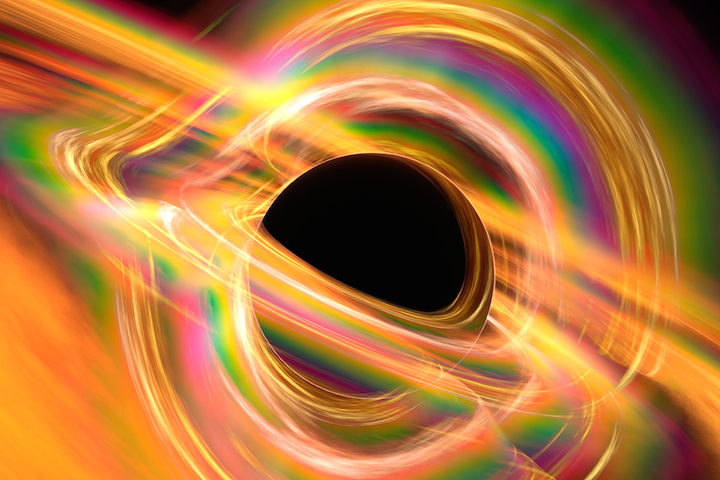2.08.2017

Dark matter hitting black holes could be the source of some fast radio bursts – mysterious blasts of radio waves that come from billions of light years away, first detected 10 years ago.
The stuff we see in space – stars, planets and gas – only makes up about 18 percent of the mass of the universe. The rest is dubbed dark matter, which can’t be seen except through its gravitational interactions with everything else.
Nobody knows exactly what dark matter is, but one hypothesis is that it is formed of still-theoretical particles called axions. These particles, if they exist, would be very light, long-lived, and only interact weakly with other matter around them.
Learn more at New Scientist Live: Join astrophysicist Carole Mundell on a whirlwind tour of black holes
Aiichi Iwazaki at Nishogakusha University in Tokyo says that because the early universe was smaller and offered more chances for axions to attract each other, they would have clumped together to form axion “stars”. Their tendency would be to cluster near the centre of galaxies, making them more likely to pass near the supermassive black holes that sit there and run into the accretion discs of gas that surround them.
“If there are many axion stars in the centres, we expect that some of them collide with the black hole accretion disc,” says Iwazaki. The magnetic field of the disc would cause some axions to decay into individual photons that are then seen on Earth as a fast radio burst (FRB), reaching us at the lower energies of radio wavelengths. There would be enough photons that the signal would still be bright.
This mechanism may also explain why some FRBs repeat at irregular intervals. So far, only one repeating burst has been found: FRB 121102, located in a galaxy some 2.5 billion light years away.
|
Ads by ZINC
|
|
|
According to Iwazaki, such an effect could result from an axion star passing through a black hole’s accretion disc over and over. It would do so at irregular intervals until the disc’s magnetic field converted enough axions to photons that the axions could no longer form a compact clump.
In 2015, Iwazaki theorised that FRBs were the product of axion stars hitting the magnetic fields of neutron stars, the corpses of stars several times the sun’s mass. That wouldn’t explain the repetition seen from FRB 121102, because neutron stars don’t have accretion discs that would simply pull material off the axions rather than destroying them.
Axion reaction
Leslie Rosenberg at the University of Washington in Seattle says Iwazaki’s idea could be supported by mainstream physics, and that suggesting exotic sources for unexplained phenomena can be useful in any case.
One issue with Iwazaki’s model is that he assumes axions interact more strongly with magnetic fields than is suggested by many other theories, says Rosenberg.
That said, axions are an attractive hypothesis for dark matter because they address some open questions in particle physics and don’t require a lot of additions to the standard model, says Joerg Jaeckel at the University of Heidelberg in Germany. The standard model is the prevailing theory of particle physics, and has survived every test so far.
But it’s probably better to opt for more conventional explanations first, says Shami Chatterjee at Cornell University in Ithaca, New York, who discovered the repeating FRB. He says the galaxy in which his team found FRB 121102 shares many characteristics with the places where we see certain kinds of supernovae and gamma ray bursts.
If that’s not mere coincidence, he says, the FRBs may also be powered by the types of features found in those locations – such as a young magnetar in a wind nebula or a supernova remnant.
Quelle: New Scientist
